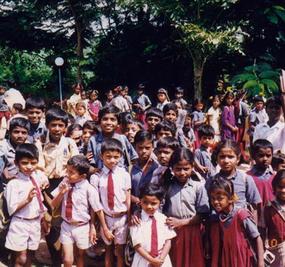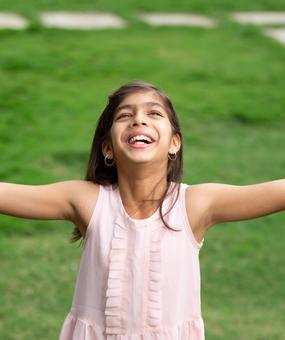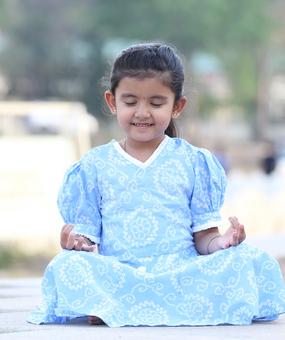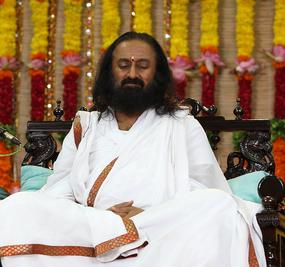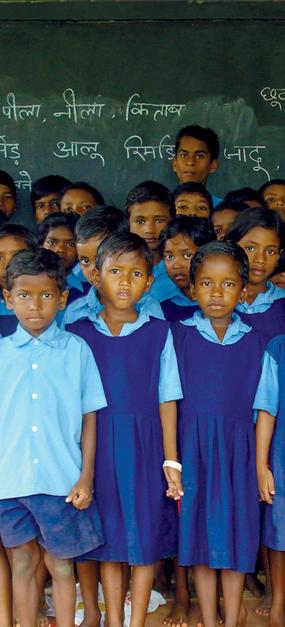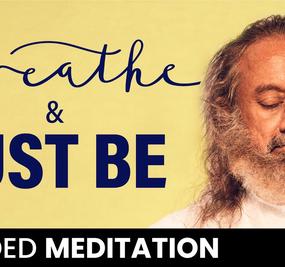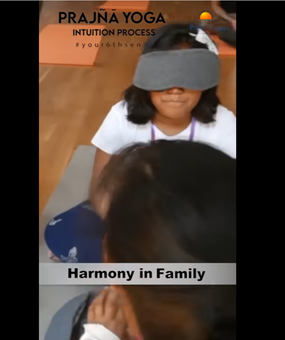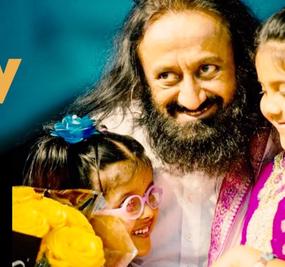How often have you caught yourself looking wondrously at your child, admiring the energy, quickness, and dexterity before you? The pure, raw talent is awe-inspiring. One moment later, you make the inevitable ‘mistake’ of blinking your eyes. And, ironically, those very same qualities drive you up the wall. Because, like it or not, children occasionally put their natural talents towards less-admirable ends – talking back, fibbing, and giving excuses to name a few of their milder transgressions.
You might have observed some new tricks and diversions during the long online classes that they have been exposed to during the pandemic. Playing online games or checking YouTube updates during classes, sauntering off to see what the sibling is up to while being logged in – children keep you guessing. It is part of their charm. And it is all right when it is within limits.
20-20-20: Quick eye exercise
Staring at the screen for long hours can be tiresome and tiring for anyone. Ask your children to do this simple 1-minute exercise to relax their eyes. After every 20 minutes, they must look at a point 20 feet away and blink for 20 seconds.
Meditation to channelize energy
Undoubtedly, there is an abundance of positivity in children; but left to itself, it can become destructive. Parents struggle to channelize the innate energy and talent purposefully and productively so kids pursue worthier goals than giving lip. One of the most seamless and tested ways of doing this is meditation.
Whether you are trying to help your fidgety eight-year-old child to sit down and focus, or attempting to counsel your moody teenager to communicate respectfully, meditation can be that facilitating factor that bridges the generation gap that inevitably develops between parent and child over time. Several, research-backed benefits of meditation can help you tame the (adorable!) wildness in your child, smooth their rough edges, and lend them grace and charm that age may or may not teach them.
There’s a whole world of meditation out there to explore – from the benefits of meditation, short meditation techniques for children and teens, to some techniques and tips to make meditation more child-friendly.
Benefits of meditation for your kids
With meditation, the masked innate nature of your child comes out. And this innate nature is pure and beautiful. And brings joy. In this space, children are relaxed, calm, and energized. Meditation lends focus to the restless child, sensitizes the careless child, composes the nervous child, and softens the aggressive child. So, it naturally follows that parents should take advantage of this simple tool for their children and especially teenagers, who are, by nature, moody and restless.
Perhaps the burning question in your mind at this point is, “How do I get my child/teen to meditate? He/she doesn’t want to.” So, we have come up with some simple techniques to help you broach the Big ‘M’ with your kid(s). You might find some of the tips we have mentioned useful as well. Since children can mean the younger 8 to 12-year age group as well as the maturer 13 to 18-year teenagers, we have suggested a few variations for each group with each technique.
Short meditation techniques for Kids
1. Observe your breath as if it was your best friend
The best way to start meditation for your children is to ask them to close their eyes and breathe in and out slowly. And just observe the breath for 2-3 minutes. Have them say ‘Hello’ and ‘Bye’ to their breath as they inhale and exhale respectively.
Relax your facial muscles exposed to long screen hours
Increased screen time for children has made Sukshma Yoga, a simple yoga technique for relieving tense facial muscles, absolutely necessary. How often do we pay attention to those indispensable sense organs that work day in and day out for us? No better time than now to exercise the eyes, eyebrows, ears, mouth, chin, and cheeks. It can be the warm-up exercise required to energize children before classes.
2. Breathe your way into meditation with pranayamas
After a good physical session outdoors, children usually come home tired. Sometimes, they are upset because they have had a disagreement with their friends or they are moody because, well, kids are kids! At this time, give them your full attention. Ask them to wash up and sit down with you. To help them get over their feelings of conflict and exhaustion, ask them to close their eyes, and take deep breaths.

Once you have ensured that they are stationary, ask them to do the Bhramari Pranayama. This is a fun breathing technique where they make a sound like a bee buzzing. The pleasant vibrations that they experience will help them calm down and go within almost instantly. Another great breathing exercise that will help children get over their weariness is the Bhastrika Pranayama. This exercise will not only get rid of exhaustion but also energize your child.
Pro tip: Ask your child to meditate after some physical exercise
It is important that children engage in physical exercise. Encourage them to play sports or do yoga asanas. This will help them utilize their physical energy and make them less restless. You will find them ready and willing to listen to sit in one place when they are tired.
Note: For the 8 to 12-year-old age group, these pranayamas are as good as meditation. Ask them to do it for 5 minutes in all. For 13 to 18-year-olds, you can ask them to sit quietly for 5-10 minutes with their eyes closed with a quiet sense of awareness of their breath.
3. Begin your day with a simple mantra for meditation
Children normally need some instructions. While their myriad thoughts are swift and varied, they generally don’t enjoy spending time by themselves, especially those under the age of 10. You might discover that even the quiet ones do not like to close their eyes and sit alone. It might even scare them. In such a scenario, it would be a good idea to give them the security and support of a mantra.
Note: 8 to 12-year-olds could say Om Namah Shivaya – slowly and clearly, out aloud, and then sit quietly for 2-3 minutes. This will give them something to do while they have their eyes closed, making them less restless and fidgety. 13 to 18-year-olds could chant Om Namah Shivaya mentally and move into meditation for 5-10 minutes.
The benefits of these three powerful words will seep into them seamlessly over time. Some children even say this mantra to themselves when they are feeling nervous or diffident. You can also play this devotional chant by Bhanumathi Narasimhan to help your child meditate.
4. Chant Sanskrit shlokas to ground children
Children are greatly influenced by their environment – TV shows, friends, and peers. All these and their age help them set up residence in an imaginary world that is sometimes far removed from reality. Sometimes, this is a defense mechanism to help them live in their reality, (a reality they do not like) without being touched by it. It takes some maturity (which may be beyond the child) to learn to live in the real world without being adversely affected by its turn of events.
Research studies have shown that the rhythmic tones and vibrations created when we chant shlokas improve the neurolinguistic (melodious) effect within us, helping us feel healthy and positive.
Nithya shlokas are chants for children that help release the young mind from illusion, making them feel comfortable in their own skin, in their own environment. You can buy the music tracks of Nitya Shlokas here, or the book of chants here. Play or chant these shlokas as your child meditates.
Note: The sponge-like mind of the 8 to 12-year-old makes it easier for them to learn shlokas quickly. This would also be a great morning meditation for your temperamental teenager(s). Keep it short and sweet and you will have a win-win with all age groups.
Pro tip: Keep it short and simple
20 minutes of meditation might be tedious and tiresome for children. You will definitely encounter a few stumbling blocks if you try to force them for so long. Moreover, even if you manage to tie them down (a la Krishna!) the first time, chances that they will pry themselves loose (a la Krishna!) are high. And, worse, you will find it difficult to approach them a second time as they will not indulge you again.
So, don’t be too ambitious from the outset. The operative word is ‘short’. Ask them to meditate for 5-10 minutes. You will find that short meditations for kids are the most effective ones. As a thumb rule, the number of minutes of meditation should correspond to the age of the child – 10 minutes for a 10-year-old should work. You can also try Gurudev Sri Sri Ravi Shankar’s 7-minute guided meditations.
If you have a teenager at home, who is ready for slightly longer sessions, you can try this 15-minute morning meditation with Gurudev Sri Sri Ravi Shankar.
5. Glide into Aura Guided Meditation
How do you get rid of tension effortlessly and fill yourself with energy? Ask your kid to simply sit and then let the soothing and friendly voice of Gurudev guide your child easily and lightly through the aura guided meditation. The best thing is that there is no effort. Children come out of this feeling refreshed and in harmony with their breath.
Note: For the 8 to 12-year-age group, some guidance by parents would help. Again, keep it short and simple so your child comes out of it wanting to meditate again another day. Teenagers can benefit from Gurudev’s instructions.
6. Participate in group meditations/Satsangs
Children, especially teens, tend to ape their friends. So, the best way to get your child to meditate is to do it in groups.
For 8 to 12 year-olds, you could try 30-minute play sessions with 10 minutes dedicated to meditation. You will hear a few giggles and spy a few peeks at first, but once children realize that some of their friends are sincerely trying to meditate, they will feel inspired to do the same. And being creatures of habit, doing it regularly will make this practice a part of their daily routine. It becomes a natural extension of their favorite activities.
For the maturer 13 to 18-year-olds could join The Art of Living satsangs – a positive space where knowledge and truth, joy and laughter are shared.
Pro tip: Approach your child through their friends
Children are very impressionable, and the impressions, more often than not, are of their friends and peers. You will have a better chance of convincing your kids to meditate if their friends do it. So, you can ask their friends to give an honest account of how meditation helps them. Sometimes, it helps to just give examples of friends who meditate. They might agree simply to ‘not be left out’!
7. Ease into Yoga Nidra guided meditation
Sometimes, children are so tired after their playtime that they won’t co-operate to even sit upright. In such a case, what if they could lie down and meditate? Many kids find this easier to do as it is relaxing and effortless. So, the best meditation for kids when they resist sitting upright is the Yoga Nidra meditation. Even if they fall asleep, it is all right. They can continue meditating once they have had enough rest. They might discover that resting with awareness is even more relaxing than sleep. You are unlikely to come across resistance from any age group for this mediation!
Simple 5 Minutes Meditation techniques for Kids:
- With eyes closed, ask them to take a deep breath, and chant Om loudly as they release their breath simultaneously.
- Young children love a good challenge. Simple Surya Namaskars (Sun Salutation Pose) are just perfect for them. They could start with six rounds and then gradually increase it to 12, 18, and so on. Ask them to lie down for 5-10 minutes after that.
- Jumping is part of children’s daily movements. Ask them to do some jumping and hopping exercises, then FREEZE! And then, sit still for two minutes.
- Take them out into nature, ask them to gaze at the sky, or the greenery around them in quiet reflection.
Special short meditation techniques for teenagers
1. Ram Dhyan guided meditation
This is another innovative guided meditation that can help your child meditate. In Sanskrit, Ra means light and ma means me, so Rama means the light within me. This meditation uses the sound of the word ‘Ram’ to move effortlessly from noise to silence. This simple meditation can help children delve within themselves to connect with their inner selves.
This meditation activates the various chakras in our body. Chakras correspond to nerve centers in our body. ‘Ha’ means pain/ suffering and ‘Ri’ means ‘remover of’. When we chant Hari Om, we turn the flow of energy in our body, which in turn converts negative emotions into positive emotions. So, play this guided meditation while your teenager meditates.
3. Transforming Emotions guided meditation
No one knows the highs of peaks and the depths of valleys as well as tempestuous adolescents. They flip-flop between good and bad times, exaggerating each unrealistically. It is not their fault really, the age-related hormones are acting upon them, as they constantly try to adjust to their expanding physical and mental selves. It is the time in their life when they reach the crossroads of their academia, when their emotions confuse them, and their bodies undergo enormous changes.
Gurudev’s guided meditation can help them transform their extreme emotions, taking them to a stable and positive space where they are surrounded by tranquility.
4. Blossom in your smile guided meditation
Who knows better than children what a wholehearted smile is! In this guided meditation, the positive effect of your smile is used to ward off all negativity. This can be particularly useful to your perpetually misunderstood teenager struggling to carve a niche for himself/herself in the world. Follow Gurudev as he leads your child into a happy world where they blossom into responsible and caring beings that you feel proud knowing.
Post meditation tip
As soon as your children are done with their meditation practice, let them engage in some creative pursuits like painting.
The left and right side of the brain
The left side of the brain is responsible for logic, analysis, and order while the right side is responsible for creativity, arts, and intuition. Meditation helps you strike a balance between both sides. So, you are able to be imaginative and intelligent at once!
Post meditation, children are able to sift through the mental clutter and find their creative side. Some kids find the results spilling onto their canvas. See if yours is one of them! If they are, you won’t have to thrust it into their schedule and endlessly remind them to practice. They will want to – on their own.
Another immeasurable benefit of meditation is that you will find that your interactions with them are devoid of conflict. Your communication and connection with your kids will become stronger than ever before – a priceless benefit, wouldn’t you say?
If you’re looking for learning-friendly techniques that help children release their anxieties, fears, and stress, where learning happens through fun-filled play and activities, try the Online Utkarsha Yoga (for 8 to 13-year-olds) and Online Medha Yoga (for 13+ to 18-year-olds) programs. These simple and naturally designed programs will strike a natural, transformative chord within your child.
Written with inputs from Shreya Chugh, Faculty, Art of Living




